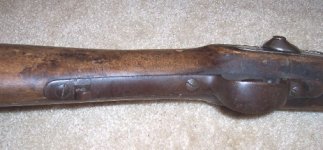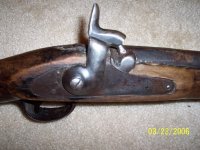I have come across an odd Enfield pattern musket that I can't identify. The interesting thing about it is that there are 3 screws in the lock behind the hammer. It also has a sling attachment point at the rear of the triggerguard. All the metal parts are steel. The only marking I can make out is faint 1863 or 4 on the lock in front of the hammer. I'll try to take it apart and clean it up to see if any other markings are visible. Any ideas what it is?
You are using an out of date browser. It may not display this or other websites correctly.
You should upgrade or use an alternative browser.
You should upgrade or use an alternative browser.
Odd Enfield copy
- Thread starter SOF
- Start date
Welcome SOF:
I think what you have there is a Spanish Enfield made in Madrid, Spain (Spanish Model 1860 Rifle). I cannot see the rear sight by your photos, but if it is clamped on the barrel, this is a sure sign it is Spanish. From what I can tell from your photos, it matches the Spanish Enfield seen in “Firearms From Europe,” second edition, by Whisker, et al., 2002. Pages 136-138 I think show your weapon with the three screws and a sling swivel mounted on the heel of the trigger-guard. “Dates of 1861, 1862 and 1864 have been observed.” Its American Civil War usage is uncertain: “William Edwards’ ‘Civil War Guns’ credits the model with Civil War usage but doesn’t cite any proof of its alleged use. Union ordnance records do not contain any listings of Spanish arms. It is also likely the arm was obtained through the Liége trade as it was manufactured in the Madrid arsenal . . . There is a possible Confederate association”--perhaps through Cuba.
I think what you have there is a Spanish Enfield made in Madrid, Spain (Spanish Model 1860 Rifle). I cannot see the rear sight by your photos, but if it is clamped on the barrel, this is a sure sign it is Spanish. From what I can tell from your photos, it matches the Spanish Enfield seen in “Firearms From Europe,” second edition, by Whisker, et al., 2002. Pages 136-138 I think show your weapon with the three screws and a sling swivel mounted on the heel of the trigger-guard. “Dates of 1861, 1862 and 1864 have been observed.” Its American Civil War usage is uncertain: “William Edwards’ ‘Civil War Guns’ credits the model with Civil War usage but doesn’t cite any proof of its alleged use. Union ordnance records do not contain any listings of Spanish arms. It is also likely the arm was obtained through the Liége trade as it was manufactured in the Madrid arsenal . . . There is a possible Confederate association”--perhaps through Cuba.
Enfield
SOF,
I agree with Dr. Beach that it is an altered Spanish Model 1860 Rifle, made in Madrid and based on the British pattern 1853 Rifle. The rear sight was clamped to the barrel and could have easily fallen off. The only problem with the identification is that the distance between the end of the lockplate to the first barrel band depression in the stock looks too short for the conventional length Model 60 Spanish.
Look on the lockplate above the date for "Madrid" and a crown stamp. BTW the date has to be 1864, they were only dated 61/62/64. Also look on the upper barrel flat for an oval containing a crown over "AZ".
It looks like the barrel has been shortened and the stock altered, removing the first barrel band with the sling swivel and moving the second band back a bit.
Just a humble opinion.
TomH
SOF,
I agree with Dr. Beach that it is an altered Spanish Model 1860 Rifle, made in Madrid and based on the British pattern 1853 Rifle. The rear sight was clamped to the barrel and could have easily fallen off. The only problem with the identification is that the distance between the end of the lockplate to the first barrel band depression in the stock looks too short for the conventional length Model 60 Spanish.
Look on the lockplate above the date for "Madrid" and a crown stamp. BTW the date has to be 1864, they were only dated 61/62/64. Also look on the upper barrel flat for an oval containing a crown over "AZ".
It looks like the barrel has been shortened and the stock altered, removing the first barrel band with the sling swivel and moving the second band back a bit.
Just a humble opinion.
TomH
I got the barrel and lock off. I can read an M in a circle, and a PM in an oval stamped on the inside of the lock, along with the numbers 21 and 44. There is too much crud on the top of the barrel to see anything. on the underside of the barrel I can see what appears to be a crown over TG all in an oval. There is also something like nB with a star over it. I really need to clean it off to see more. Would a light application of a bronze brush be appropriate? How do you clean the crud out of the bore? On the outside of the lock the date is 1864 under a crown, but that's all I can see. Would you happen to have a pic of an 1860 Spanish musket? I couldn't find anything online. Thanks again, you guys are great!
Scott
Scott
I agree with TomH, now that I can see the whole rifle--the rifle has been altered. There was a Spanish Enfield Cavalry Carbine (p. 139 of “Firearms From Europe”--shorter than your weapon)--almost looks like someone tried to make themselves a carbine--but a bit too long for that, I suspect?
Spanish Model 60
Horace,
It looks like the original barrel band position can bee seen about halfway between the end of the barrel and the lock. There is a slight narrowing of the stock there that would have served as a "stop" for the band. The deeper narrowing between that point and the lock seems to be an alteration.
The problem with altered weapons is not being able to ascertain when the alteration took place. So many wartime weapons found their way into the hands of farmers and ranchers who altered them for their own use. Sights and swivels were removed and barrels shortened to make the weapon more suitable for buckboard or saddle use. Plus certain weapons were very popular, like the Spencer Carbine (the 19th century equivalent of the Ruger Mini 14), resulting in site contamination and bullet patterns appearing in battles that pre-dated the weapon.
SOF,
Be very careful when cleaning! Take a Zen approach ... "Less is More". Personally I would not use a brush unless there is serious corrosion, and even then be very ginger about its use.
That is an unusual find in the US, not many Madrid firearms found their way here and few have surfaced today.
TomH
Horace,
It looks like the original barrel band position can bee seen about halfway between the end of the barrel and the lock. There is a slight narrowing of the stock there that would have served as a "stop" for the band. The deeper narrowing between that point and the lock seems to be an alteration.
The problem with altered weapons is not being able to ascertain when the alteration took place. So many wartime weapons found their way into the hands of farmers and ranchers who altered them for their own use. Sights and swivels were removed and barrels shortened to make the weapon more suitable for buckboard or saddle use. Plus certain weapons were very popular, like the Spencer Carbine (the 19th century equivalent of the Ruger Mini 14), resulting in site contamination and bullet patterns appearing in battles that pre-dated the weapon.
SOF,
Be very careful when cleaning! Take a Zen approach ... "Less is More". Personally I would not use a brush unless there is serious corrosion, and even then be very ginger about its use.
That is an unusual find in the US, not many Madrid firearms found their way here and few have surfaced today.
TomH




